Persistence of Haloperidol in Human Brain Tissue
Abstract
OBJECTIVE: After discontinuation of neuroleptic drugs, their antipsychotic and antiparkinsonian effects are still present for a prolonged period. It is not known whether the extended effects of neuroleptic drugs in humans are due to the continued presence of drug in brain tissue or to long-lasting drug-induced physiologic changes. The aim of this study was to directly examine haloperidol concentrations in human brain tissue in relation to drug-free time. METHOD: Haloperidol concentrations were measured in five regions (temporal cortex, cingulate gyrus, caudate nucleus, dentate nucleus, corpus callosum) of the postmortem brains of 11 patients previously treated with haloperidol. Haloperidol was analyzed by means of high-performance liquid chromatography with ultraviolet detection. The half-life in brain tissue was estimated by a population kinetic analysis. RESULTS: Haloperidol concentrations in the human brain tissue were 10–30 times higher than optimal serum concentrations used in the treatment of schizophrenia. Haloperidol concentrations appeared to be homogeneously distributed across different brain areas within a single patient. There was no apparent relation between duration of treatment and mean haloperidol concentration. Higher doses of haloperidol seemed to be related to higher concentrations in brain tissue. The elimination half-life from brain tissue was calculated to be 6.8 days. CONCLUSIONS: The results may have implications for clinical treatment decisions and the design of clinical research protocols. Patients exposed to haloperidol cannot be considered to be free of residual effects of the drug for a number of weeks after withdrawal.



